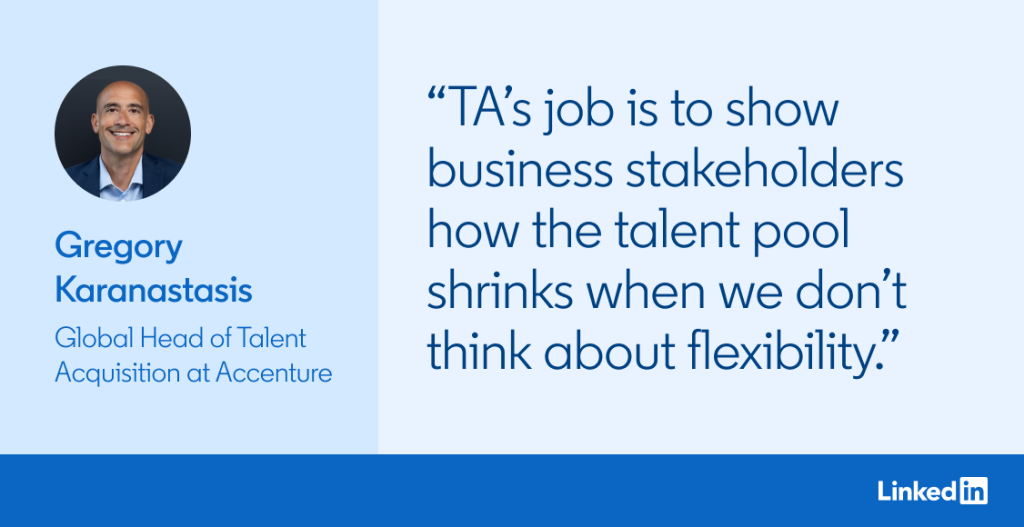Likewise, the importance of flexible work as an employee value proposition (EVP) grew by 10% among all job seekers and 14% among Gen Z job seekers from 2021 to 2023.
Show decision-makers how offering remote work options can help your company stand out from competitors: Employers with flex work policies are 16% more likely to have candidates accept their InMails and they’re 29% more likely to receive an application from a candidate who viewed one of their jobs, according to LinkedIn research.
2. Study the talent pool and share what you’ve learned
One of the big advantages of allowing employees to work from home is that it removes geographic boundaries when searching for talent. Rather than hiring the best person who lives near one of your offices, you can find the best person anywhere in the world.
“When we’re searching for niche roles with limited talent pools,” Erin said, “I often push the conversation to ask, ‘Is your goal to hire the best person in Chicago? Or is your goal to hire the best person?’”
Lifting location barriers also helps improve diversity recruitment. A study conducted by professors at the Wharton School of the University of Pennsylvania found when jobs at tech startups switched from in-person to remote, the transition led to a 15% rise in female applicants, a 33% jump in applicants from historically marginalized groups, and a 17% increase in applicants overall.
Remote work can be a better option for women who often shoulder more of the childcare responsibilities in a family. Likewise, remote work is attractive to women and individuals from historically marginalized groups because it allows them to avoid microaggressions in the workplace, the researchers said.
You can drive these points home by using a talent analytics tool such as LinkedIn Talent Insights. With Talent Insights, you can pinpoint where pockets of desired candidates do — and don’t — reside and demonstrate how offering remote work options vastly expands the talent pool. Likewise, check census data and demographic information to understand where pools of underrepresented talent are concentrated, Erin advises.
“TA’s job,” says Gregory Karanastasis, global head of talent acquisition at Accenture, “is to show business stakeholders how the talent pool shrinks when we don’t think about flexibility.”
3. Be a storyteller
Gather facts and anecdotes from your own experience with candidates. Then take this evidence and formulate a narrative that will help the C-suite better understand the importance of offering flex work.
If your company limits remote or hybrid options, tally the number of candidates who have declined job offers and cited your strict in-office policy. Keep tabs on the number of times candidates ask about your remote work policies. Canva, for instance, found one-third of candidates we’re asking about flexible work policies in interviews, says Amy Schultz, the company’s global head of talent acquisition.
Don’t forget to tell human stories. Look for examples inside your company where offering candidates the option to work from home solved a problem or yielded positive business results. Be sure to note the positive impact having a flex policy will have on your company’s reputation and employer brand.
Monitor the remote-work policies of other companies. If your rivals are gaining an advantage in the battle for talent because they’re allowing employees to work offsite, that might influence leaders at your company to do the same.
“TA professionals understand their business — not just internally,” says Mark Smith, senior director of global talent acquisition at Medtronic. “They should be able to report on the external market in terms of how talent rivals are managing workplace flexibility to better inform their internal customers and partners.”
4. Showcase your ideas
Listen to the C-suite’s concerns about remote work and recommend solutions.
Company leaders, for instance, may see in-person work as essential for such things as fostering collaboration, mentoring, and building company culture.
Demonstrate how these activities can still be done successfully even when workers are remote. You might also recommend that your company offer travel stipends so that remote workers can visit the office regularly or that it fund quarterly or semiannual offsites that bring everyone together in a thoughtful way.
If senior executives are unwilling to budge from requiring employees to work onsite, you could suggest that they build satellite locations in regions that have more diverse talent pools.
Final thoughts
Convincing the C-suite that offering flexibility is in its best interest is no easy task. Be prepared to hear pushback and arguments that the value of having workers in the office outweighs the benefits of allowing them to work from home.
Celebrate your successes. Any progress you make is further evidence that talent professionals have an important role to play in shaping larger strategic direction and in improving the lives of people at their companies.
“Your information can help you change the decisions being made at the most senior levels of the company,” Erin noted in her Hire Connect speech. “And when those decisions change, the opportunities available to individuals shift. You don’t just fill a role. You shape the future.”










